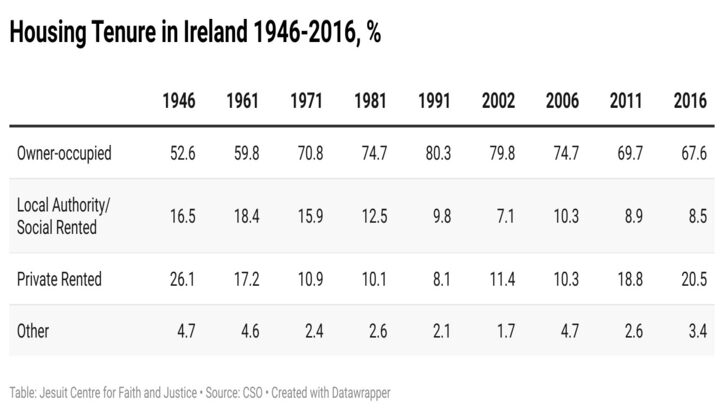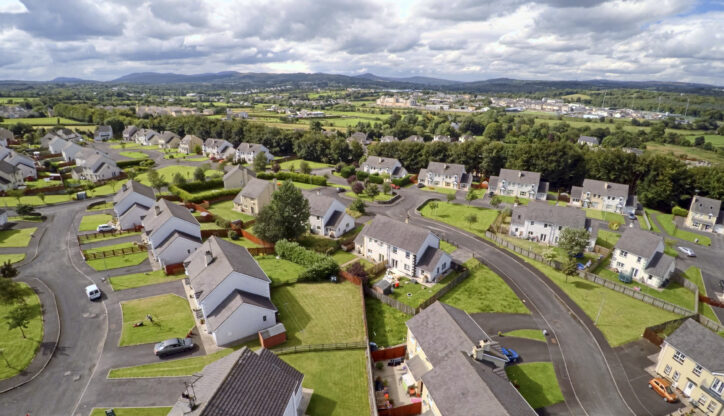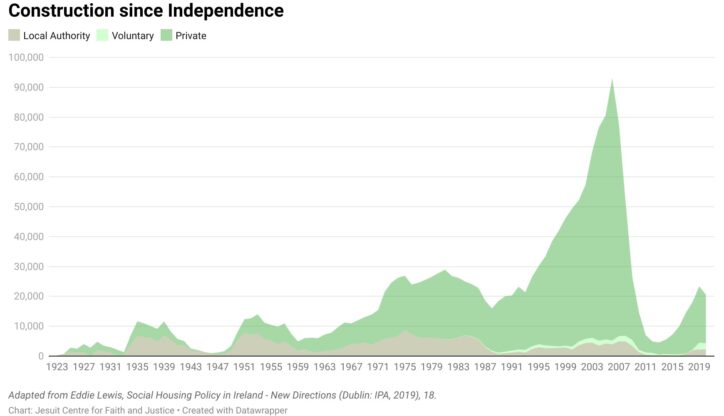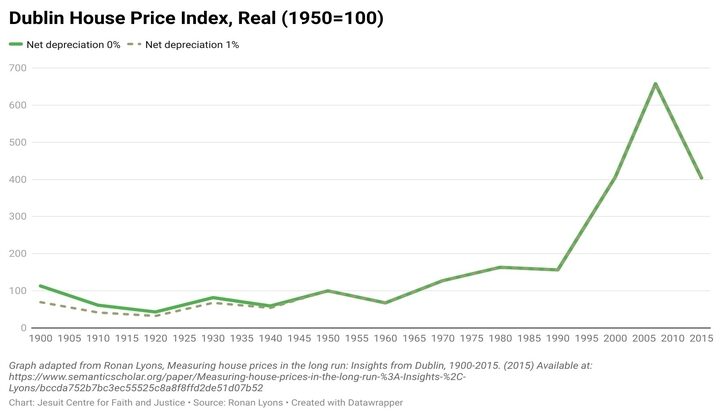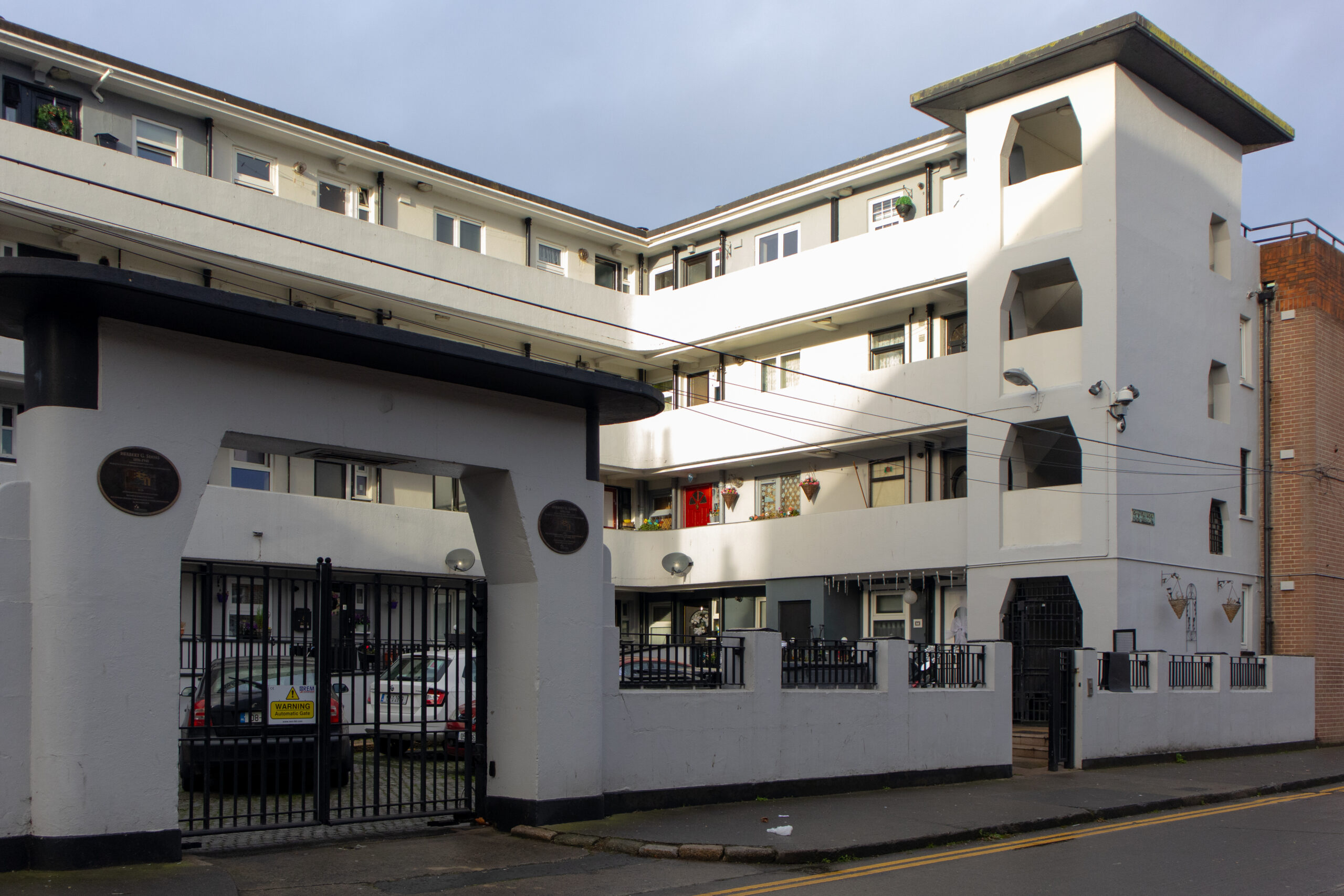
Padraic Kenna
Professor Padraic Kenna lectures in housing law and policy and land law at NUI Galway. He is a specialist on housing rights and has published six books and over 50 journal articles on these topics.
Introduction
The Democratic Programme of the first Dáil did not specifically address housing policy – although it affirmed that all right to private property must be subordinated to the public right and welfare, and that no child should suffer hunger or cold from lack of food, clothing, or shelter. The legacy of British rule, a new peasant proprietor class, a good public administration system, and a lot of poor housing, provided a unique foundation for Irish State policy-making. This paper traces the development of Irish housing from the foundation of the State in the Republic of Ireland (and does not cover Northern Ireland) to the current centenary celebrations. The periods before and after World War II involved significant State housing provision, although by the 1980s two-thirds of this housing had been sold to tenants, creating a basis for a housing market. Major structural changes after the 1960s had created a new landscape for policy making, although Ireland had avoided the housing challenges of other European countries – rebuilding of bombed cities, large scale migration, and problems of integration. Yet, many were excluded from Irish State policy, although it was only in the 1990s that an ‘underclass’ was identified, largely living in State housing and experiencing few of the opportunities of other Irish citizens. Of course, the Celtic Tiger utterly changed everything, representing the pinnacle of free-market and property ownership, but also the integration of Irish housing with global financial flows. The relentless push for more and more property ownership continues, but the financialisation of housing, globally, has altered the political debate. House price bubble risks to economic stability are now managed by EU institutions. New challenges are emerging, and the framing of housing exclusion debates in terms of international human rights means that the debate is no longer local. Maintaining the Irish property-owning democracy is becoming very costly.
Legacy of British rule
The Easter Rising and the formation of the new State had built on the emancipatory struggles against the feudal system of landownership in Ireland, generated over 700 years of Norman influence.[1] The distribution of land to the many landless peasants across Europe from 1789 had led to significant social and political changes.[2] The new peasant proprietors “are always found to be conservative in the best sense of the word, deeply interested in public peace and order, self-denying and saving, prosperous and anxious to promote the good education of their children”.[3] Concepts of autonomy, self-reliance, ownership and freedom from feudal and colonial oppression were layered into Irish Republican ideals of liberty, equality and solidarity. These principles informing early Irish State housing policy must be seen in the context of the existence of 316,000 small-holdings –“a peasant proprietorship of a certain standard”[4] which had been created by 1920 – covering half the population.[5] Freehold titles for the small land-holdings, could be registered in a State guaranteed Land Registry, making property and land ownership (and disputes) a central part of the Irish conversation and debate until recent times.[6] This elaborate State-backed property registration system provided the basis for widening and protecting home-ownership, with the rise of urbanisation. It facilitated the expansion of the original ‘property owning democracy,’ in land to one based on housing, and which also legitimised similar State subsidies to housing as had been applied to land ownership.
But the new State also inherited a very poor housing stock, with some 10% of urban dwellers and 38% of rural dwellers living in third- and fourth-class homes – two- to four-roomed mud huts with windows and one-roomed mud huts, respectively.[7]
The Dublin Housing Inquiry Report (1914)[8] showed that half of the city population lived in tenement houses or second- and third- class small houses.[9] Yet, an array of British public health and housing legislation provided a legal and regulatory framework for sanitation and slum clearance. The Housing of the Working Classes (Ireland) Act 1908 had provided a State subsidy for urban housing, although this only housed 2.5% of Dublin’s population by 1914.[10] In rural areas the Labourers (Ireland) Act 1883 had created some 50,000 labourers’ cottages by 1921.[11] The Housing (Ireland) Act 1919 had extended the British post-World War I “Homes fit for Heroes to live in” provisions to Ireland. Associated assessments showed (among the half of local authorities who carried it out) a need for 61,648 dwellings, remarkably similar to the 61,880 units required under the 2020 assessments of housing need – 100 years later (although the Irish population has increased by 50% in that time). After 1921, aside from the British civil service model, only two elements of British housing policy were implemented in Ireland; the provision of housing for returning Irish World War I sailors and soldiers,[12] and the Increase of Rent and Mortgage Interest (War Restrictions) Act 1915 (passed to avoid revolution in Red Clyde), renewed regularly after Independence and introduced permanently in 1946.
Up to World War II
The first Dáil Éireann was alive “to the urgency of the housing problem” and established the “Million Pound Scheme” creating 2,000 local authority homes by 1924, a feat all the more remarkable in the context of a shortage of State funds, and the need to rebuild much of the infrastructure damaged in the War of Independence. Legislation in 1924 marked the beginning of a long tradition of State assistance for private sector housing provision.[13] By 1932, some 10,000 dwellings were built by local authorities, and 16,500 by private builders. However, slum conditions persisted.
Housing legislation in 1931 concentrating subsidies towards the poorer section of the population was inherited by the incoming Fianna Fáil Government, and the next decade established the formula for State assistance to local authorities in the form of annual subsidies on loan charges. In the decade after 1932 some 82,000 homes were built, the vast majority (public and private) with State subsidies. Indeed, by 1940, some 41% of the Irish housing stock had been built by local authorities, far higher than that in England and Wales (25%). Of course, this investment in housing, as today, had important wider effects. In many ways it amounted to a public works policy.[14] This required that Irish materials be used in all grant-aided houses, such as Killaloe slates, Dolphin’s Barn bricks, cast iron from Hammond Lane and Irish cement.
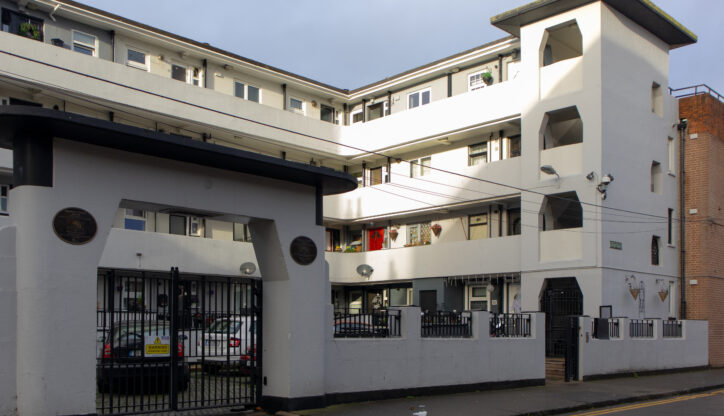
Corporation housing at Chancery Street in Dublin, designed in 1933 by Herbert Simms. Photo: Martina Madden
Housing Architect Herbert George Simms. Ruth McManus suggests that the development continuum at the time involved interaction between the State, local authorities, public utility companies and private speculative builders, rather than a strict division between public and private development.[15] The outbreak of war in 1939 slowed housing activity, which did not recommence until 1948–1949.
World War II to the 1970s
The 1948 White Paper, Housing – a Review of Past Operations and Immediate Requirements, indicated that 43,000 houses were needed in urban areas, and 16,000 in the countryside. Legislation in 1948 established regulations for the management and letting of local authority houses, with new priorities for newly-weds and elderly people, followed by those with a family member suffering from tuberculosis, and then persons living in unfit and overcrowded housing.
Expenditure on housing provision rose dramatically and continued throughout the 1950s.[16] By 1964, a further 74,000 private and 63,000 local authority homes were built with State support.[17] This period was described as the time when “Keynes came to Kinnegad” and even Ken Whitaker extolled the benefits of Keynesianism at the time.[18]
Eddie Lewis points out that between the 1930s and the 1950s local authorities had provided between half and two-thirds of total housing output. Remarkably, some 97% of dwellings built in Ireland in 1957 received some form of State aid, a situation only matched in Sweden – which had adopted a radical social-democratic programme in housing after World War II.[19] One American commentator pointed out in 1965 that:
The vast effort to create a large citizenship of home owning families has unleashed a thoroughly conservatising force in the Republic … The people of Ireland today live in what might be regarded as the world’s most heavily subsidised houses built under the aegis of a most complex set of economic supports.[20]
Despite mass emigration (with a million people leaving the country in the 1950s and 60s), and the massive State investments, there was still a relatively high level of housing need in 1960s Ireland. In 1963, there was public outcry after two children were killed when a building in Fenian Street collapsed on them.[21] The Dublin Housing Action Committee, formed in the 1960s in response to housing shortages, took direct political action and successfully squatted buildings to oppose redevelopment plans.
The sudden population increase and urbanisation from the late 1960s created a new demand for housing, which largely translated into escalating house and development land prices, on the edge of the major cities. While the Catholic Church held enormous sway over the public, civil and social institutions of the State, including education, health and social policy until the late 1960s, major social developments were nevertheless taking place.[22] The Buchanan Report in 1967 recommended regional planning authorities, with national and regional growth centres be developed in Athlone, Cork, Dublin, Drogheda, Dundalk, Galway, Limerick, Sligo and Waterford with large-scale housing provision.[23] The Housing Act 1966 consolidated all housing legislation and provided local authorities with a range of new powers. Arguably, the worst models of housing development were adopted with the system-build high rise housing, the pinnacle of which must be the seven 15-storey blocks named after the seven signatories to the 1916 Proclamation in Ballymun.[24] Little attention was paid to the need for housing estate management, amenities, shops and the social, educational or other needs of the new community established there.[25] The legacy of poor housing policy and deteriorating estates has since diminished the social and economic opportunities of many Irish citizens.[26]
However, it was boom time for developers. The Kenny Report[27] showed that the price of serviced land in County Dublin had leaped from £1,100 per acre in 1960 to £7,000 per acre in 1971. The Report recommended establishing designated areas where land for house building could be acquired by local authorities at pre-planning value, plus 25% of the value created by the zoning. The recommendations of the Kenny Report were never implemented, and it was only through the Tribunals of Inquiry of the 20th century that the true level of influence over politicians by developers was exposed.[28]
In rural areas, large-scale development of bungalows in the 1970s symbolised the new prosperity, based on the bible of bungalow standard house plans – Bungalow Bliss.[29] Home ownership in Ireland had reached its zenith by 1991.
The 1980s and 1990s
Recession in the 1980s had curtailed State expenditure, but some fundamental changes taking place in Irish social housing would have long-term effects on Irish society. The ‘surrender grant’ in 1984 led to tenants with higher incomes leaving local authority estates, and these estates were now becoming ‘residualised’ and stigmatised, by European standards.[30] Studies were showing major social exclusion and poverty, which was exacerbated by the heroin epidemic of the late 1980s and early 1990s. [31] The management of these estates was described as having “all the faults of the British system which was its model – centralisation, paternalism, lack of tenant involvement.”[32] From 1992 local authorities had to draw up and adopt a new written statement of their housing management policy.[33] After 1995, tenant involvement became a condition of central government funding for local authority estate management improvements – but the protection of the housing assets, rather than the personal, social and economic development of tenants appeared to a priority. Remarkably, and unlike most other European countries, there is no national representative body of social housing tenants in Ireland. The ‘control of the poor’ principle was again evident in legislation introduced in 1997 creating a new term ‘anti-social behaviour’ applying to social housing tenants and their families.
In the 1990s, Labour housing ministers pioneered major legislative and policy reform. This included requiring local authorities to counteract undue segregation in housing between people of different social backgrounds, protection for private tenants, and a new role for housing associations in the provision of social housing.[34] The Housing (Traveller Accommodation) Act 1997 created an obligation on local authorities to create Traveller Accommodation Plans. Towards the end of the 1990s, the economy was beginning to recover and house prices had again started to rise dramatically. This led to a number of initiatives, including the Planning and Development Bill 1999, modelled on British examples, which enabled local authorities to acquire up to 20% of sites (over four units) at pre-planning value, for social and affordable housing provision.
Of course, Irish constitutional property rights were not far below the surface and the Bill was referred to the Supreme Court to examine its constitutionality. [35] The Supreme Court held that the Bill did not constitute an ‘unjust attack’ on property rights. The proposals benefited individuals in need of housing at the expense of landowners, in the interests of the common good, but were constitutionally permissible. The Court stated that where Irish legislation interferes with a constitutional [property] right, it must: (a) meet a clear social objective; (b) be rationally connected to the objective and (c) not be arbitrary, unfair or based on irrational considerations, and impair the right as little as possible.[36] A total of 5,721 social housing units and 15,114 affordable housing units were delivered under Part V from 2002–2011.
But many were questioning whether there was something special about landed property in Ireland, and whether the law was acting as a barrier to the development of affordable housing. The All Party Oireachtas Committee on the Constitution Report on Private Property (2004)[37] examined the way development land acquired such high values, compared to agricultural land, arising from State largesse in planning, zoning, connection to water and other services and infrastructure. Sharing this increased ‘value’ or betterment between the landowner and the wider community is now regarded as integral to a democratic society. Housing for All – a New Housing Plan for Ireland (2021) promises radical, new, modern ‘Kenny Report’-style powers to ensure sharing of the increase in land values from re-zoning decisions, and greater community gain.[38]
The Excluded
The Irish State excluded from its policy considerations many of those seen as outsiders by the influences of Roman Catholic norms, including people with disabilities,[39] homeless people, unmarried mothers, children born in poverty or to unmarried parents, lesbians, gay men and others. The State provided some institutional “care” through contracts with agencies (often religious agencies), thereby insulating it from political accountability for any breach of standards. The abuses which took place in these institutions and the discrimination against groups of people is only now coming to light. Among the many groups of people excluded from housing policy were the 40% of the population who were forced to emigrate in the first 50 years of the Irish State.[40]
There was a noticeable absence of direct female influence on Irish housing policy formation. In the early years of the State in Ireland, where women had been largely charged with maintaining the home and children, poor housing conditions increased the burden. However, the poor design of houses built by the Land Commission and Local Authorities, alongside the fact that not all homes had a water supply until the 1970s, and electricity was only partially available after the 1950s, demonstrated the absence of women’s influence on housing policy.[41] Only in 1964 did the Department of Environment set standards which required the provision of a separate bathroom, a WC, hot water facilities, and “liveability factors” including laundry and cooking facilities and adequate storage and shelving.[42]
Of course, those without property were also treated as outsiders in the State. The homelessness and nomadic lives of Travellers has long been recorded, yet all housing legislation and Government housing reports until the late 1980s failed to refer to Traveller accommodation needs. The Report of the Commission on Itinerancy (1963) showed that there were 1,150 Traveller families living on the roadside,[43] but there were still 591 in 2019.[44] A Report by the Irish Human Rights and Equality Commission (IHREC) shows that Traveller children comprised 12% of homeless children in emergency accommodation, although Travellers accounted for only 1% of the population in 2020. Housing associations, (now known as Approved Housing Bodies) with charitable and public benefit objectives, and often founded by religious organisations, today provide specialist housing and support services for many hitherto excluded groups.
New Challenges
Housing rights
Irish housing policy is increasingly being measured against Ireland’s human rights obligations, advanced in terms of the unenumerated rights and social policy of Bunreacht na hÉireann,[45] and the adoption of the International Covenant on Economic, Social and Cultural Rights (ratified in 1989) and the European Social Charter (ESC) ratified in 1964 and Revised Charter ratified in 2000). While these are not justiciable in national courts, the Irish State has accepted obligations to apply these international housing rights, providing regular reports to international monitoring bodies. However, the State is now raising the Irish Constitutional property rights provisions as a barrier to further incorporation of housing rights.[46]
The UN report on Ireland (2015), highlighted insufficient social and Traveller housing, homelessness and lack of access to affordable rented or bought housing, as housing rights issues.[47] It also expressed concern over increasing numbers of homeless families and children, and the lack of culturally appropriate housing for members of the Roma and Travelling community. In FIDH v Ireland [48] the Council of Europe held that Ireland violated Article 16 ESC [on the right of families to legal, social and economic protection] by failing to provide adequate standards of housing for a sizeable number of families living in local authority housing. The case of ERRC v Ireland[49] found a violation of Article 16 ESC through the practice of habitual evictions of Travellers, and the adoption of inadequate housing legislation. The European Convention on Human Rights requires that any eviction from home requires an official proportionality assessment.[50] The UN Convention on the Rights of Persons with Disabilities (ratified in 2020) requires that persons with disabilities have the right to live independently in the community, with appropriate in-home and community services.[51] The European Union Charter of Fundamental Rights contains a range of housing rights, including the right to respect for Services of General Economic Interest as set out in national law – such as social housing. [52] EU consumer law is also impacting Irish housing, with all mortgages being examined for unfair contract terms.[53] Both the Mercy Law Centre, and Irish Congress of Trade Unions’ Homes for Good’ campaign, among others, promote a referendum placing the right to housing in the Irish Constitution.[54]
Homelessness and housing need
The Democratic Programme of the first Dáil promised to end the institutionalised poverty of the Poor Law system and workhouses.[55] The Report of the Commission on the Relief of the Sick and Destitute Poor in 1927 found 3,257 homeless people including 901 children, and in January 2021 there were 5,987 homeless adults and 2,326 homeless children in Ireland.[56]
Religious groups were encouraged to take on a major role in this area in the new State, and only in the 1970s did emerging voluntary groups adopt new approaches beyond charity.[57] The Housing Act of 1988 officially defined homelessness for the first time, although State obligations involve only providing funding to agencies to provide accommodation. The definition is based on a local authority assessment in relation to absence of any form of shelter, although housing needs are also examined in relation to other criteria.[58] These local authority assessments of housing need and homelessness have taken place since 1989, and the latest in 2020 shows that there were 61,880 households assessed by local authorities as qualified for housing support, with almost half unable to afford their housing costs, and 10.5% living in a homeless shelter, institution or emergency accommodation.[59] Significantly, the numbers living in unfit housing are very low due to the level of housing development since the 1990s.
Legislation in 2009 redefined State housing obligations to providing ‘social housing support’, opening a range of responses other than the provision of council housing, such as the extensive leasing schemes from the private sector – Rental Accommodation Scheme (RAS) and Housing Assistance Payment (HAP). The subtle but profound change has not yet been recognised by many political advocates today. In fact, this new form of ‘social housing support’ mainly through State increased financial support to private rental tenants has to led to Ireland being regarded in 2019 as among the EU Member States with the highest level of social housing – defined as the proportion of the population of tenants with below market rents (22.3%).[60]
In the same year, legislation ushered in major reforms in Irish land law “to repeal enactments that are obsolete, unnecessary or of no benefit in modern circumstances,” and to modernise the law. Home loan mortgages were redefined as consumer or ‘housing loans’ – a major and historic divergence from the general law of mortgages in land law, almost unique to Ireland in its integration of EU consumer law with Irish property law.[61]
Prices and rent
In 2021, housing has become unaffordable to rent or buy in Ireland for many, but the State provides significant subsidies to the market to ensure that those excluded by that market have a home. The capital housing budget for 2021 was €2bn while some €1.3bn is spent on current expenditure, including €218m on homelessness services and €20m on Traveller Accommodation.[62] The annual expenditure on the various supports to the private rented sector, including RAS (€133m.), HAP (€558m.) and Rent Supplement means that over one-third of private tenancies are subsidised by the State. This was before Housing for All was announced in October 2021 promising a capital spend of €4bn per annum.[63]
Climate change
Climate change will impact significantly on housing in Ireland and already the Climate Change Advisory Committee has suggested that Irish homeowners will need to spend between €25bn and €75bn on retrofitting over the next 30 years.[64] The National Development Plan (2018-2027) allocated exchequer funding of €4 billion from 2018-2030 to support energy efficiency improvements across the residential sector.[65] The 2020 Programme for Government, formulated with the Green Party as a negotiating party, is providing €5 billion in additional funding for retrofitting. [66]
The Celtic Tiger transformed Irish housing forever
The accession to the European Union in 1972 had a profound impact on Irish society and economy and on the housing system. Aside from the increased prosperity following European Aid in the 1980s, the integration into the European economy impacted on housing in some unanticipated ways. The ‘social partnership’ (and associated NESC Reports) consensus policy-making between the social partners of employers, trade unions and the State between the 1980s to 2010 led to the development of a modern European welfare state. This was hastily constructed, described by O’ Donnell as ‘building a ship at sea’ – with rapid growth from the late 1990s, on top of a highly politicised infrastructure.[67] In this rapidly evolving State expansion period controlling the property developer and associated financial actors in the housing system proved impossible. The period of the ‘Celtic Tiger’, from the 1990s to the crash of 2008, was without precedent, especially for our understanding of Irish housing. Significantly, between 1998 and 2007, almost 300,000 Irish women joined the labour market, historically increasing female activity rates from 57% to 67%.[68] The two-person mortgage became the norm.
Sadly, the economic revival from the mid-1990s turned into a full scale credit-driven house price boom – where any increases in productive income were almost immediately captured in rising house prices. Such was the extent of capital flows into housing (increasing from 32% to 70% of GDP between 2000 and 2006) that Ireland experienced the fastest rise (350% between 1997 and 2007) and deepest fall (50% between 2007 and 2012) in house prices of any nation in the world. The consequences were catastrophic, with the State bailing out the main banks, nationalising all building societies, and then being forced to seek an EU bailout for the State itself in 2010. The crash led to a recession and crisis for heavily indebted mortgagors, with 14% of home loan borrowers and 24% of buy to let borrowers in arrears in 2015. Banks then began to sell portfolios of distressed loans to international investor ‘vulture funds’ and a major surge in mortgage possession cases occupied the Circuit Courts – even until 2019.[69]
Difficult as it is to accept, Irish housing policy killed the Celtic Tiger.[70] The regulatory capture of financial regulation and the hegemony of a developer/banker/politician regime had been intensified by the ideological and utopian notion that everyone should be a homeowner.[71] The idea of housing as a right (and not a commodity) was overwhelmed by the heady ideology of property ownership and ‘market-speak’.[72] Legislation in 2009 created even more routes to home-ownership, where new local authority tenants could switch from renting to the ‘incremental purchase’ of their dwellings.[73] Of course, the financialisation of housing had begun in the 1980s with the deregulation of Building Societies, and integration of housing finance with global capital flows,[74] but failure to address the impact of a Euro credit bubble after 2004 was devastating.
After the crash the EU reconfigured banking supervision and financial governance across Europe, with direct prudential supervision of the main banks from Frankfurt, and new policies on levels and limits to mortgage lending. The risks of Irish credit-driven house prices bubbles are now closely monitored.[75] The fact that the ECB licenses and franchises financial institutions to create vast amounts of credit, based on lending against rising house and associated land prices, has enormous effects on the ability of Ireland and other EU Member States to implement holistic, tenure-neutral, and inclusive housing policies, and ensure a supply of adequate and affordable housing for all.[76]
The European Semester promotes housing policies to tackle housing supply shortages, dysfunctional housing markets, macroeconomic imbalances and insufficient stocks of social housing. Of course, a great many EU measures, from environmental protection to construction products to public procurement have already impacted on Irish housing. These EU law and institutional measures are now actually constitutive of the Irish national housing system rather than marginal add-ons. Indeed, since 2001, Irish social housing has been defined in the context of a Service of General Economic Interest, which must comply with State aid rules.[77]
Yet, the ideology of property/home ownership persists, despite, or perhaps driven by, the decline of home ownership rates among 25-39 years olds. The latest Programme for Government (2020) states that:
…home ownership should be within reach of all our citizens. We will bring forward measures over the lifetime of the Government to enable home ownership for more people through increased supply and interventions that make home ownership more affordable… An overriding objective of our housing policy is to make homes more affordable. We will: Progress a State-backed affordable home purchase scheme to promote home ownership.[78]
But subsidies for home ownership fuel rising house prices – the problem which the subsidised schemes are ultimately seeking to address.[79] As Eoin Burke-Kennedy has pointed out, the “dogma that increasing supply will unlock many of these issues is becoming increasingly jaded … Not once in our recent history has it [increased supply] improved affordability.”[80]
The following figure shows the pattern of new housing construction from the foundations of the State, with the dramatic peak over 90,000 homes in 2006, followed by a cliff-like drop.
Significantly, all boosts in ‘supply’ coincided with major increases in house prices. Ronan Lyons, who established the now ubiquituous website – Daft.ie, containing almost all houses for sale or rent in Ireland, prepared a Dublin house price index from 1900 to 2015.
What is interesting about these two graphs is that they show house prices increasing at the same time as a major boost in supply – the similarity patterns between 1995 and 2007 are too significant to be coincidental. The key to understanding all this is the flow of credit/finance into housing in this period. Of course, housing markets are unlike other markets. House prices do not fall with increased supply, as housing is both a consumption and investment commodity. This is now more true than ever, as international and institutional investors buy most new apartment blocks, both driving and anticipating higher prices. Indeed, periods of house price growth have coincided with massive increase in available finance – especially before 2007. However, access to mortgage finance to buy a home is now limited to those on the highest incomes who compete with international real estate investment funds. These are transforming the housing landscape in Dublin, marking the globalisation of Irish housing 100 years after the founding of the State.[83] Is this what Wolfe Tone meant about Ireland taking its place among the nations of the world? The relationship between housing systems and monetary and financial policy has yet to be fully developed in Irish housing policy development.[84]
Conclusion – Bringing Coherence to ‘Housing’ Policy
Understanding how housing systems function and change is one of the most enduring challenges in social policy. While many policy reports such as the iconic NESC Housing in Ireland: Performance and Policy (2004)[85] identify key housing policy objectives, housing as property, and housing as a market, remain the dominant Irish policy paradigms. Almost all media and political debates treat housing as the central element of the Irish property market. Current lamentations that this ‘market’ model is not providing housing for those in need demand more supply side State subsidies to sustain this ideological construct. Norris characterises the Irish housing system as epitomising an asset-based welfare approach, where housing policy is imbued with strong property rights and self-reliance principles, although involving a high level of State financial and other support.[86] She identifies the major change as occurring in the late 1980s when the State was no longer able to provide funding for housing at the same level, and turned towards the finance markets (along with de-regulation of building societies) for housing funding.
Eddie Lewis presents the development of Irish housing in two phases – from independence, and after the Housing Act 1966, which for the first time provided an integrated and modern national framework for the management of social housing. While undoubtedly contributing to the housing stock and promoting home ownership, social housing has also left a legacy of deteriorating estates and crumbling infrastructure that too often has diminished the social and economic opportunities of those growing up in these estates.[87]
Eoin Ó’Broin TD points out that the key features of the Irish housing system are an under-provision of public non-market housing and an over-reliance on the private market to meet housing need.[88] This involves massive subsidies to landowners, developers, landlords and investment funds. Housing is too fundamental a right to be left to the boom-and-bust cycle of the market, and any alternative functional housing system must place the large scale provision of non-market housing at its very centre.
Aside from the sale to tenants of two-thirds of the 330,000 social housing units and other supports to home-ownership, in the first century of the State,[89] the push for more and more property ownership, as the underlying aim of housing policy, is patently clear. If the expansion of housing as property and wealth, leading to a ‘property-owning democracy’ was the objective of Irish State housing policy, then it has succeeded. Housing accounts for two-thirds of net worth household wealth of €830bn. [90] Ireland has a robust political system, which weathered the rise of fascism, numerous economic depressions, and even a bailout of the State itself. According to Eurostat, Ireland has among the lowest average housing costs and homes with the most rooms person on average in the European Union, with one third of home-owners owning their property outright. [91] There is relatively little unfit housing, although it has become too expensive for emerging new households, and the poorest are falling off the housing ‘ladder’ into homelessness. But it is not really surprising that Irish housing policy has been about expanding property ownership. Civic republicanism values autonomy and self-reliance (including freedom from control of feudal monarchs), enabling citizens to practice virtuous citizenship.
Property and housing ownership in Ireland have bestowed a set of values, and civic republican parties continue to promote these values today, through State funding, after 100 years. But these objectives are becoming very costly and difficult to sustain, and not everyone can participate on an equal basis.
That these values also overlapped with some parodies of Victorian petite bourgeois values of the Irish Roman Catholic Church is, of course, too obvious to be a coincidence. But of course, that is not the full story here, and it is important to recognise the role the Catholic Church as a social institution played in the stability of the Irish State. Catholic social teaching on respect for human dignity and participation in society for the common good in society, together with more recent teachings on oppression, the role of the State, subsidiarity, social organisation, concern for social justice, and issues of wealth distribution are contributing to the creation of a more inclusive, holistic and sustainable housing policy.[92] These and other approaches, are inspiring and creating new ways of seeing housing, which act as a counter to the hegemonic discourse of housing as property, or an asset. This will promote new forms of housing which will be aesthetically and socially inclusive, but also based on equity in society and a sustainable planet.
Housing ownership in Ireland has bestowed an enduring set of values. But if there is any lesson from 100 years of Irish housing it is that housing policy can diminish, or it can reinforce, social and economic inequality.
Footnotes:


